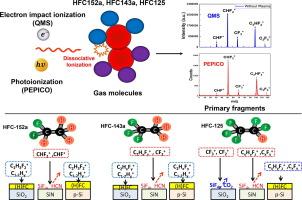当前位置:
X-MOL 学术
›
Appl. Surf. Sci.
›
论文详情
Our official English website, www.x-mol.net, welcomes your
feedback! (Note: you will need to create a separate account there.)
Hydrofluoroethane plasma etching of SiN, SiO2, and poly-Si films with CHF2CF3, CF3CH3, and CHF2CH3
Applied Surface Science ( IF 6.3 ) Pub Date : 2024-11-15 , DOI: 10.1016/j.apsusc.2024.161815 Tran Trung Nguyen, Toshio Hayashi, Hiroshi Iwayama, Makoto Sekine, Masaru Hori, Kenji Ishikawa
Applied Surface Science ( IF 6.3 ) Pub Date : 2024-11-15 , DOI: 10.1016/j.apsusc.2024.161815 Tran Trung Nguyen, Toshio Hayashi, Hiroshi Iwayama, Makoto Sekine, Masaru Hori, Kenji Ishikawa

|
Plasmas containing hydrofluorocarbon gases (CHF2CF3, CF3CH3, and CHF2CH3) are used for the selective removal of SiN, SiO2, and poly-Si films when manufacturing large-scale integrated circuits. Understanding the plasma chemistry of hydrofluorocarbons is important for gaining insight into the mechanisms of these selective-etching processes. The fragmental reactants produced by the reactive plasma are essential for evaluating and controlling highly accurate selective etching. This study examined such fragments using a primary dissociation ionization threshold quadrupole mass spectrometer at an electron energy of 20 eV. Their primary dissociative ionization thresholds were identified using photoelectron-photoion coincidence spectroscopy, with photon energies ranging from 10 to 28 eV. The results showed the following: (i) the CHF2CF3 molecule dissociated into ions such as CHF2+ and C2HF4+, which formed secondary ions, such as CF3+ and CF2+. The F-rich reactants effectively enhanced the etching of both SiO2 and SiN; (ii) the CF3CH3 molecule dissociated into ions such as C2H2F+ and C2H2F2+, while the dominant CF3+ remained as a crucial fragment for the primary etching of SiO2; (iii) the CHF2CH3 molecule predominantly yielded ions such as CHF2+, CF2CH3+ and CxHy+, promoting polymer film deposition on the surfaces of SiO2 and poly-Si.
中文翻译:

用 CHF2CF3、CF3CH3 和 CHF2CH3 对 SiN、SiO2 和多晶硅薄膜进行氢氟乙烷等离子体蚀刻
在制造大规模集成电路时,含有氢氟烃气体(CHF2CF3、CF3CH3 和 CHF2CH3)的等离子体用于选择性去除 SiN、SiO2 和多晶硅薄膜。了解氢氟碳化物的等离子体化学性质对于深入了解这些选择性刻蚀工艺的机制非常重要。反应性等离子体产生的碎片反应物对于评估和控制高精度选择性刻蚀至关重要。本研究使用电子能量为 20 eV 的初级解离电离阈值四极杆质谱仪检查了此类碎片。它们的主要解离电离阈值是使用光电-光离子符合光谱确定的,光子能量范围为 10 至 28 eV。结果显示如下:(i) CHF2CF3 分子解离成 CHF2+ 和 C2HF4+ 等离子,形成二次离子,如 CF3+ 和 CF2+。富 F 反应物有效地增强了 SiO2 和 SiN 的刻蚀;(ii) CF3CH3 分子解离成离子,如 C2H2F+ 和 C2H2F2+,而占主导地位的 CF3+ 仍然是 SiO2 初级刻蚀的关键片段;(iii) CHF2CH3 分子主要产生 CHF2+、CF2CH3+ 和 CxHy+ 等离子,促进聚合物膜沉积在 SiO2 和多晶硅表面。
更新日期:2024-11-16
中文翻译:

用 CHF2CF3、CF3CH3 和 CHF2CH3 对 SiN、SiO2 和多晶硅薄膜进行氢氟乙烷等离子体蚀刻
在制造大规模集成电路时,含有氢氟烃气体(CHF2CF3、CF3CH3 和 CHF2CH3)的等离子体用于选择性去除 SiN、SiO2 和多晶硅薄膜。了解氢氟碳化物的等离子体化学性质对于深入了解这些选择性刻蚀工艺的机制非常重要。反应性等离子体产生的碎片反应物对于评估和控制高精度选择性刻蚀至关重要。本研究使用电子能量为 20 eV 的初级解离电离阈值四极杆质谱仪检查了此类碎片。它们的主要解离电离阈值是使用光电-光离子符合光谱确定的,光子能量范围为 10 至 28 eV。结果显示如下:(i) CHF2CF3 分子解离成 CHF2+ 和 C2HF4+ 等离子,形成二次离子,如 CF3+ 和 CF2+。富 F 反应物有效地增强了 SiO2 和 SiN 的刻蚀;(ii) CF3CH3 分子解离成离子,如 C2H2F+ 和 C2H2F2+,而占主导地位的 CF3+ 仍然是 SiO2 初级刻蚀的关键片段;(iii) CHF2CH3 分子主要产生 CHF2+、CF2CH3+ 和 CxHy+ 等离子,促进聚合物膜沉积在 SiO2 和多晶硅表面。


















































 京公网安备 11010802027423号
京公网安备 11010802027423号